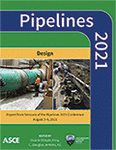Experimental Study of a Noncircular Corrugated Steel Culvert at Different Shallow Cover Depths
Publication: Pipelines 2021
ABSTRACT
North American bridge design codes recommend a minimum burial depth for culverts to prevent failure during construction or under vehicle loading. The design of flexible culverts, such as those made of corrugated steel plate, has historically focused on circumferential force in the conduit walls (i.e., hoop thrust) as the critical failure mode. However, recent studies have shown that bending stresses are often of the same magnitude as hoop stresses, especially for noncircular pipe culverts with cover depths that are at or near the recommended minimum level. To investigate this issue, an elliptical corrugated steel culvert with span of 1,650 mm, rise of 1,300 mm, and corrugation profile with a 25 mm amplitude and 75 mm wavelength was tested at different cover depths ranging from 0.1 to 1.2 m under simulated vehicle loading. The culvert’s response to live load quantifies just how much more dominant bending moment is than thrust. When combined earth and live loading is considered, moments are still important, and the results quantify the transition from a flexural, live load dominated response at extremely shallow cover depths to a more earth load dominated response at cover depths greater than 500 mm.
Get full access to this article
View all available purchase options and get full access to this chapter.
REFERENCES
AASHTO. (2017a). “Section 12: Buried Structures and Tunnel Liners.”, LRFD, American Association of State Highway and Transportation Officials (AASHTO), Washington, DC.
AASHTO. (2017b). “Section 3: Loads and Load Factors.”, LRFD, American Association of State Highway and Transportation Officials (AASHTO), Washington, DC.
ASTM International. (2017). D2487-17 Standard Practice for Classification of Soils for Engineering Purposes (Unified Soil Classification System). West Conshohocken, PA, 10.
ASTM International. (2018). A929/A929M Standard Specification for Steel Sheet, Metallic-Coated by the Hot-Dip Process for Corrugated Steel Pipe. West Conshohocken, PA, 5.
Bakht, B. (1980). Live load testing of soil-steel structures., Ontario Ministry of Transportation and Communication, Policy Planning and Research Division, Toronto, Canada.
CSA. (2017). Canadian Highway Bridge Design Code. CSA, Canadian Standards Association (CSA) Group, Mississauga, Ontario, Canada.
CSPI. (2010). Handbook of Steel Drainage & Highway Construction Projects. Corrugated Steel Pipe Institute, Cambridge, Ontario, Canada.
Duncan, J. M. (1978). “Soil-Culvert Interaction Method for Design of Metal Culverts.” Transportation Research Board, (678), 53–59.
El-Sawy, K. M. (2003). “Three-dimensional modeling of soil-steel culverts under the effect of truckloads.” Thin-walled Structures, 41(8), 747–768.
Kearns, O., Moore, I. D., and Hoult, N. A. (2020). “Measured Responses of a Corrugated Steel Ellipse Culvert at Different Cover Depths.” Journal of Bridge Engineering, 25(11), 11.
Mai, V. T., Hoult, N., and Moore, I. D. (2014). “Effect of Deterioration on the Performance of Corrugated Steel Culverts.” Journal of Geotechnical and Geo environmental Engineering, 140(2), 11.
Moore, I. D. (2012). “Large-scale laboratory experiments to advance the design and performance of buried pipe infrastructure.” Proc., 3rd Int. Conf. on Pipelines and Trenchless Technology, ASCE, Reston, VA, 805–815.
Moore, I. D., and Brachman, R. W. (1994). “Three-dimensional analysis of flexible circular culverts.” Journal of Geotechnical Engineering, 120(10), 1829–1844.
Regier, C., Hoult, N., and Moore, I. D. (2017). “Laboratory Study on the Behaviour of a Horizontal-Ellipse Culvert during Service and Ultimate Load Testing.” Journal of Bridge Engineering, 22(3), 14.
Regier, C., Moore, I. D., and Hoult, N. (2018). “Remaining Strength of Deteriorated Corrugated Steel Culverts.” Journal of Pipeline Systems Engineering and Practice, 9(2), 15.
Seed, R. B., and Raines, J. R. (1988). “Failure of Flexible Long-Span Culverts Under Exceptional Live Loads.” Transportation Research Board, (1191), 22–29.
Simpson, B., Hoult, N., and Moore, I. (2015). “Distributed Sensing of Circumferential Strain Using Fiber Optic during Full-Scale Buried Pipe Experiments.” Journal of Pipeline Systems Engineering and Practice, 6(4), 10.
Taleb, B., and Moore, I. D. (1999). “Metal Culvert Response to Live Loading: Performance of Three-Dimensional Analysis.” Transportation Research Board, 1656(1), 37–44.
Tetreault, J., Hoult, N., and Moore, I. (2018). “Pre- and post-rehabilitation behaviour of a deteriorated horizontal ellipse culvert.” Canadian Geotechnical Journal, 55(3), 329–342.
Yeau, K. Y., Sezen, H., and Fox, P. J. (2009). “Load Performance of In Situ Corrugated Steel Highway Culverts.” Journal of Performance of Constructed Facilities, 23(1), 32–39.
Information & Authors
Information
Published In
Copyright
© 2021 American Society of Civil Engineers.
History
Published online: Jul 29, 2021
Authors
Metrics & Citations
Metrics
Citations
Download citation
If you have the appropriate software installed, you can download article citation data to the citation manager of your choice. Simply select your manager software from the list below and click Download.
Cited by
- Oliver Kearns, Ian D. Moore, Neil A. Hoult, Mark C. Webb, Corrugated Steel Ellipse Culvert Response: Experimental Results Compared to Design Approaches, Journal of Pipeline Systems Engineering and Practice, 10.1061/JPSEA2.PSENG-1424, 14, 2, (2023).
